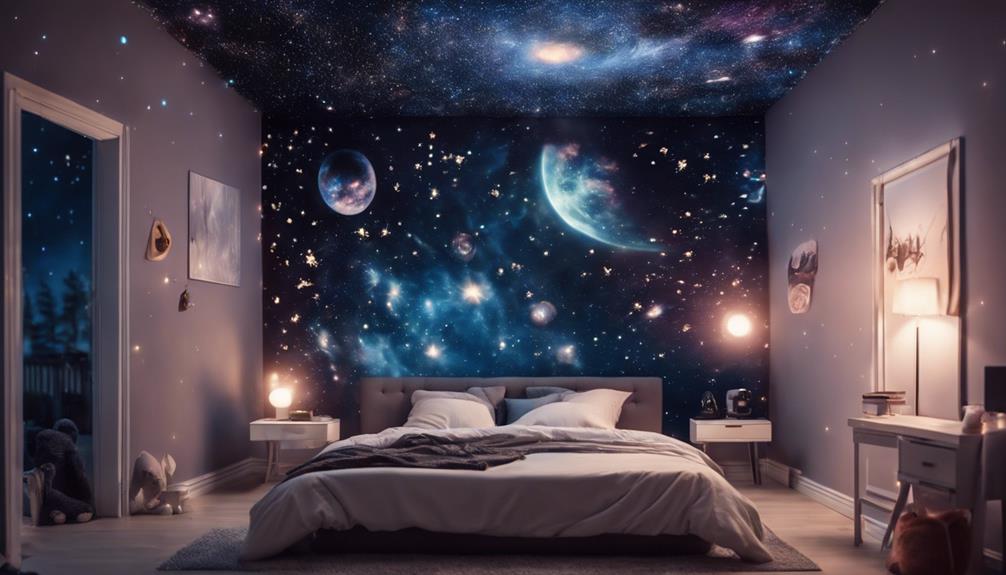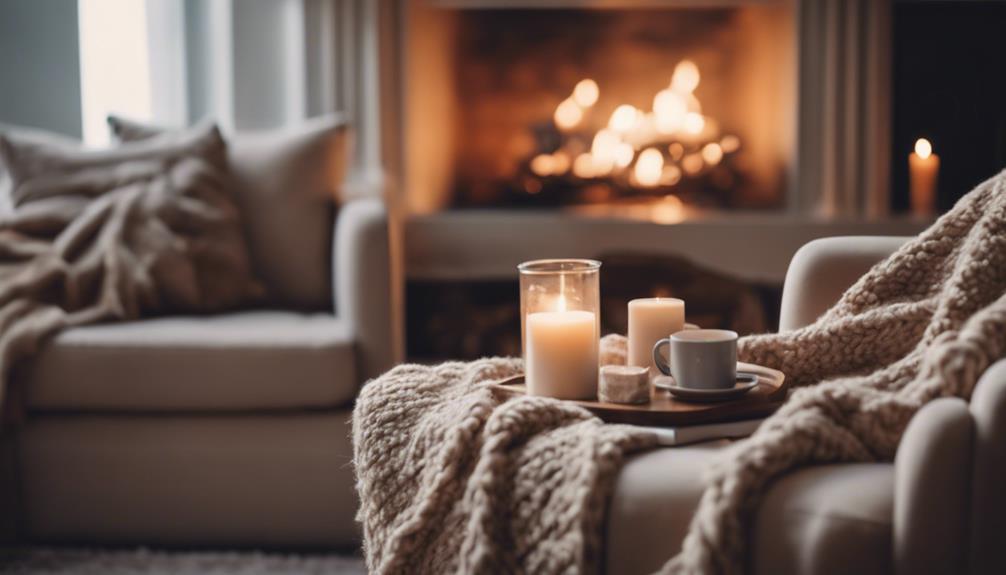If you want to create spaces that feel balanced and inviting, Feng Shui secrets are essential. Start by optimizing the flow of Chi, ensuring your rooms are clutter-free to invite positive energy. Use the Bagua map to enhance specific areas like love or wealth. Incorporate natural elements like plants and water features to boost tranquility. Remember to place furniture thoughtfully for open pathways and conversation. Light and bright colors raise vibrancy, while dark hues can weigh a space down. These tips are just the beginning; stick around to uncover more insights that will make your designs truly shine.
Key Takeaways
- Optimize Chi Flow: Arrange furniture to encourage natural energy movement, avoiding blockages and promoting a vibrant atmosphere.
- Incorporate Natural Elements: Use plants, water features, and natural materials to enhance energy and create a harmonious environment.
- Use the Bagua Map: Apply this tool to identify and amplify specific life aspects through thoughtful spatial arrangement.
- Maintain a Clutter-Free Space: Regularly declutter to support mental clarity and allow Chi to circulate freely throughout the area.
- Emphasize Natural Light: Maximize bright natural light to boost mood and energy levels, creating a revitalized living space.
Understanding Feng Shui Basics
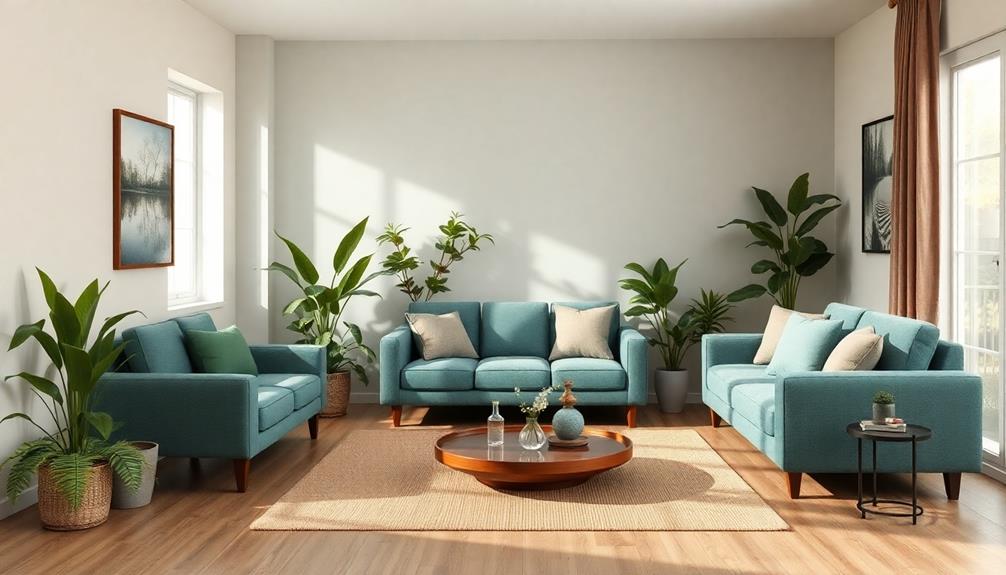
Understanding the basics of Feng Shui can transform how you approach interior design. This ancient Chinese practice emphasizes arranging spaces to optimize the flow of Chi, or life force energy, fostering harmony between you and your environment.
One of the most fundamental tools in Feng Shui is the Bagua Map, which divides your space into nine areas that correspond to key aspects of life, like wealth, love, and health. Incorporating elements from Balinese design concepts can further enhance this harmony, as they emphasize natural materials and open spaces that promote a tranquil atmosphere.
To create a balanced atmosphere, you'll want to take into account the concept of Yin and Yang, representing the harmony between passive and active energies. This balance is essential for making your space feel inviting and serene.
Additionally, the Five Elements—Wood, Fire, Earth, Metal, and Water—each contribute unique colors, shapes, and emotions that can enhance energy flow in your design choices.
Lastly, keep in mind that a clutter-free environment is significant in Feng Shui. Excessive clutter disrupts energy flow and can negatively affect your mental clarity and overall well-being.
Essential Feng Shui Symbols
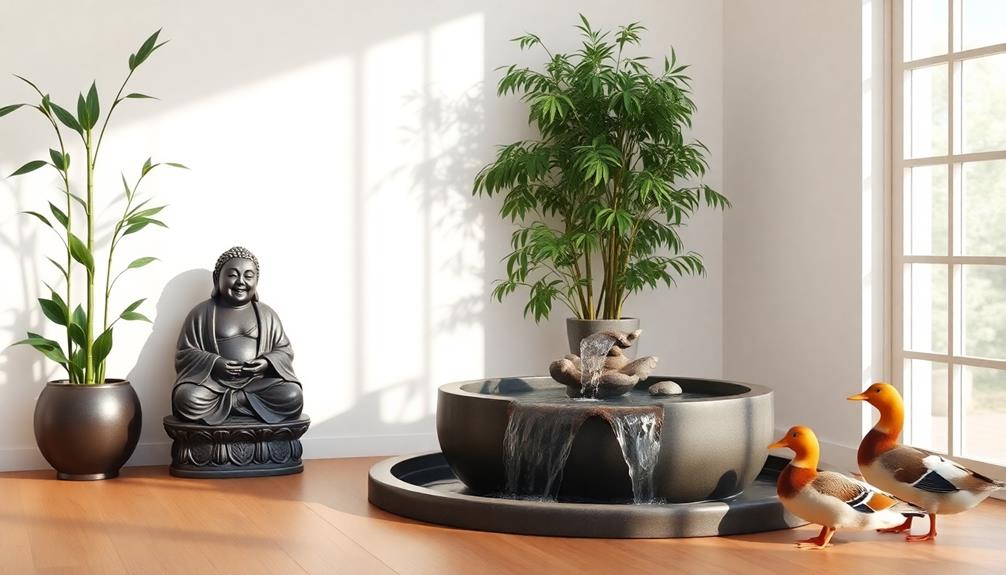
Incorporating symbols into your design can amplify the positive energy in a space and align it with Feng Shui principles. Start with the Bagua map, an essential Feng Shui tool that divides your area into nine sections, each linked to different life aspects like career, wealth, and relationships.
By placing specific energy flow symbols in these areas, you enhance the energy of that aspect. For instance, the Green Dragon symbolizes career success, while the Red Phoenix signifies wealth. You can also draw inspiration from unique art pieces, such as a Face Indonesian Decor Mask, which represents rich cultural heritage and enhances the aesthetics of a space.
Feng Shui tools like Buddha statues can promote peace, or wind chimes can uplift sound energy.
Colors and elements play an important role too. Red can boost passion and recognition, while blue promotes tranquility and wisdom.
Consider using plants for growth, crystals for clarity, or mirrors to create the illusion of space, further enhancing the energy flow in your environment.
Feng Shui Dos and Don'ts
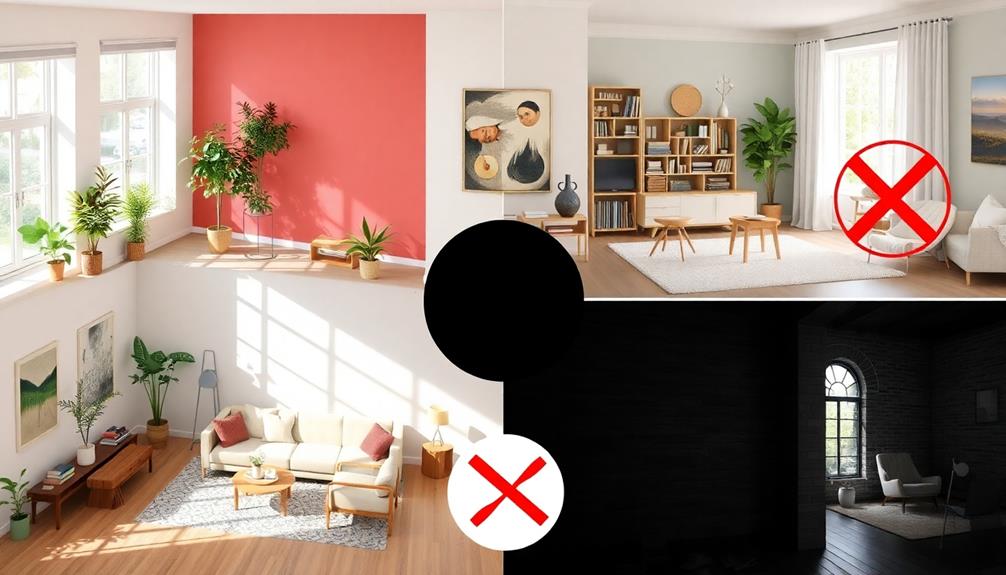
When designing a space with Feng Shui in mind, knowing the essential dos and don'ts can make a significant difference in how energy flows.
First, do declutter your spaces. A clutter-free environment is vital because clutter blocks positive energy flow and can lead to mental fatigue and stress. You can also enhance your space with vibrant decorative elements, such as Indonesian decorative pillows, which not only offer comfort but also reflect cultural heritage and add a splash of color.
Next, incorporate natural elements. Adding plants or natural materials enhances life energy (Chi) and creates tranquility. You should also let in natural light—this boosts mood and energy levels, making your space more vibrant.
On the flip side, don't use dark colors excessively. Dark hues absorb energy, creating a heavy atmosphere; instead, opt for lighter colors to promote brightness and positivity.
Additionally, avoid placing furniture against walls. This blocks energy movement; keeping furniture away from walls fosters a more open and welcoming atmosphere.
Room-Specific Feng Shui Tips
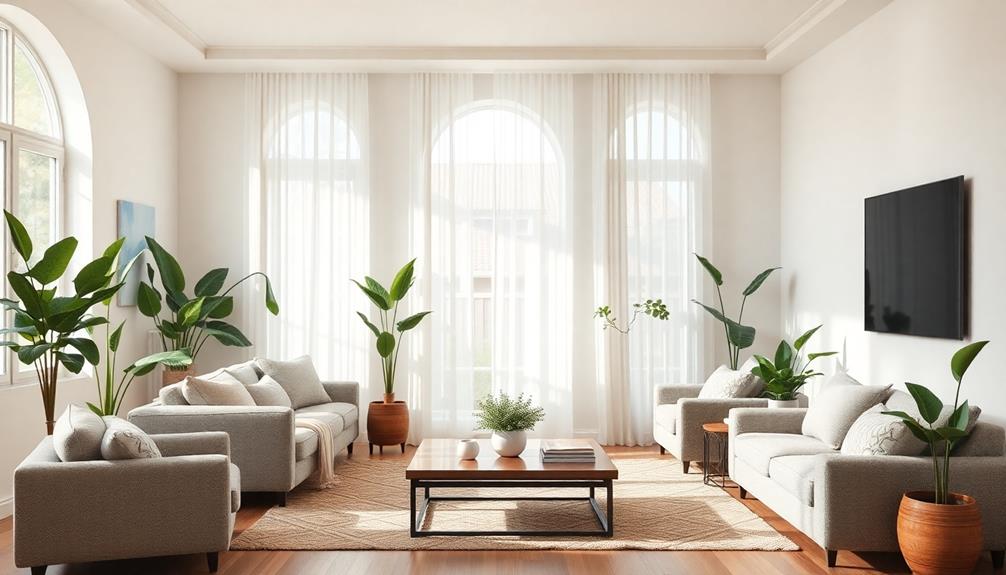
Creating a harmonious environment in each room of your home involves specific Feng Shui tips tailored to their unique functions. By applying these suggestions, you can enhance positive energy flow and guarantee a clutter-free environment throughout your space.
Incorporating elements like colorful banners or streamers can also elevate the ambiance, similar to how Indonesian party decorations create a vibrant atmosphere.
- Living Room: Position furniture to encourage conversation and maximize light exposure. Avoid overcrowding to promote positive energy flow, making your space feel inviting and warm.
- Kitchen: Keep your stove clean and positioned safely away from the sink to maintain a healthy balance of energy. A clutter-free environment on surfaces can attract prosperity and joy.
- Bedroom: Place your bed in a commanding position where you can see the door without being directly in line with it. This setup promotes restful sleep and a sense of security, essential for rejuvenation.
- Bathroom: Maintain a clutter-free environment with soft lighting and air-purifying plants. This creates a calming atmosphere and enhances cleansing energy, making your bathroom a serene retreat.
Enhancing Energy Flow
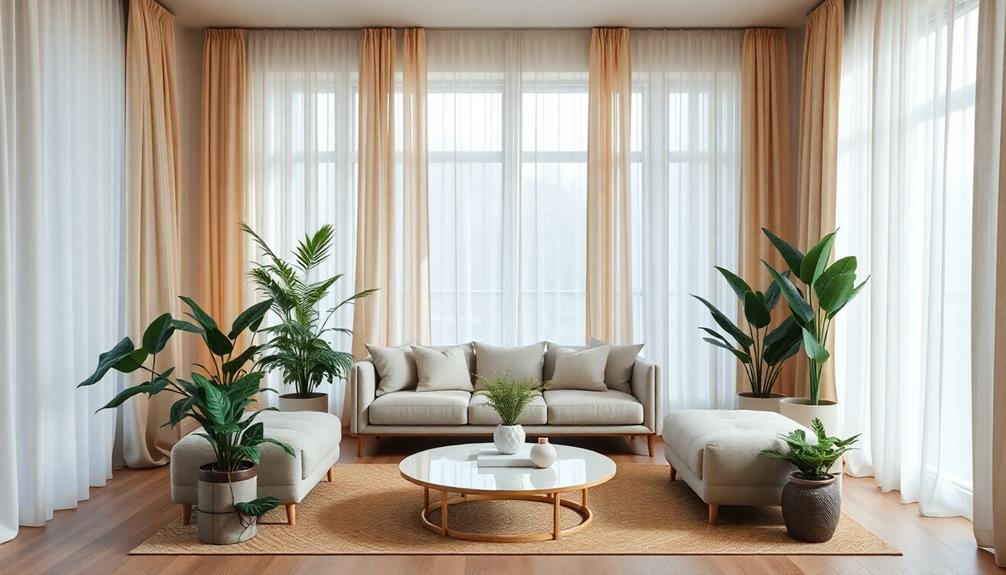
To enhance energy flow in your space, start by optimizing furniture placement. Position key pieces like beds and desks for a clear view of entrances, and incorporate natural elements such as plants and water features.
For instance, using traditional Indonesian style home decor can further enhance the ambiance by bringing in natural materials and intricate designs.
Maintaining a clutter-free environment will also allow Chi to circulate freely, creating a more vibrant atmosphere.
Optimize Furniture Placement
Furniture placement plays an essential role in how energy flows through a space, impacting both comfort and functionality. To optimize energy flow, consider these key strategies:
- Commanding Position: Position essential furniture, like your bed, desk, and stove, in a commanding position. You should be able to see the entrance without being directly in line with it, which promotes a sense of security.
- Seating Arrangement: Arrange your seating to facilitate conversation and connection. Avoid placing chairs with their backs to the entrance, as this can block the flow of Chi and create discomfort.
- Space Around Furniture: Maintain a few inches of space between furniture and walls. This allows for smooth movement and unobstructed energy flow throughout the space.
- Avoid Stagnation: Don't place heavy furniture in corners where energy can stagnate. Instead, use these areas for light decor or plants to keep the energy vibrant and active.
Use Natural Elements
Incorporating natural elements into your design can dramatically enhance the flow of energy in a space. By adding plants and flowers, you not only beautify your environment but also symbolize growth and liveliness, promoting positive energy flow in line with Feng Shui principles.
Consider integrating air-purifying plants, which improve indoor air quality and introduce the Wood element, fostering creativity and new beginnings. Water features like fountains or aquariums can further amplify this energy by attracting wealth and creating a calming atmosphere that enhances the flow of Chi.
Utilizing natural materials, such as wood and stone in furniture and decor, helps ground the energy in your space. This connection to nature fosters a sense of stability and peace.
Additionally, make certain your space is filled with bright, natural light from windows. This revitalizes energy flow, boosts mood, and symbolizes a positive future in Feng Shui practices.
Maintain Clutter-Free Spaces
A clutter-free space is essential for maintaining the smooth flow of Chi energy, as disorganization can lead to stress and hinder your mental clarity.
By decluttering your environment, you can create a serene atmosphere that promotes emotional well-being.
Here are four effective strategies to keep your space tidy:
- Regular Decluttering: Set aside time each week or month to assess your belongings. Remove items that no longer serve a purpose, allowing positive energy to flow freely.
- Utilize Storage Solutions: Use baskets, bins, or decorative boxes to hide clutter while keeping items accessible. This helps maintain cleanliness and order without sacrificing style.
- Adopt Minimalism: Focus on meaningful objects that resonate with you. Reducing visual overload fosters relaxation and stimulates creativity.
- Establish a Routine: Implement seasonal cleaning or monthly assessments to guarantee your space remains clutter-free. Consistency is key in supporting ideal Chi energy flow.
Common Feng Shui Mistakes
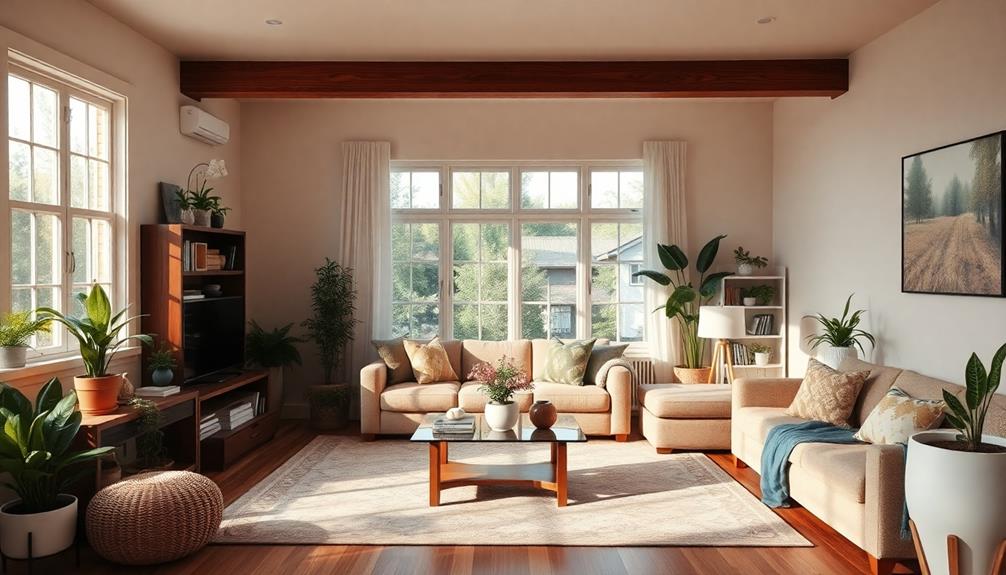
Many designers overlook how negative furniture placement can disrupt energy flow in a space.
For instance, positioning the bed or desk incorrectly can create feelings of vulnerability or stagnation.
Additionally, cluttered spaces not only block Chi but also impact your clients' overall sense of well-being.
Negative Furniture Placement
One common mistake in Feng Shui is negative furniture placement, which can greatly impact the energy of your space. Incorrect placement of furniture can disrupt the flow of energy, resulting in a less harmonious environment. Some other common feng shui mistakes include cluttered and disorganized spaces, as well as the use of harsh or unbalanced colors. By being mindful of these potential pitfalls, you can create a more balanced and positive energy in your home or office.
When you're positioning your furniture, it's important to reflect on how it affects the flow of energy. Here are four key placements to avoid:
- Coffin Position: Positioning your bed directly in line with the door can create a sense of vulnerability, leading to negative energy and disrupted sleep quality.
- Desk Against a Wall: Placing your desk against a wall limits the flow of energy, making you feel confined and uncomfortable while working.
- Excessive Bookshelves: Having too many bookshelves in a bedroom creates visual clutter, obstructing energy and contributing to a sense of overwhelm.
- Visible Bathrooms: If your bathroom is visible from the main entrance, it symbolizes a loss of energy and liveliness, negatively affecting your home's atmosphere.
Cluttered Spaces Impact
Clutter can easily pile up and disrupt the natural flow of Chi in your space, leading to stagnation in energy that affects your mental clarity and overall well-being.
When your environment is filled with excessive clutter, it creates feelings of anxiety and overwhelm, distracting your mind and hindering your focus. This makes it tough to maintain a tranquil living environment.
Closed doors and crowded entryways block positive energy from entering your home, diminishing its welcoming atmosphere.
First impressions matter, and a cluttered entry can signal negative energy right from the start. Neglected areas filled with dust and clutter symbolize stagnant energy, indicating those spaces need attention and revitalization.
Regularly decluttering not only enhances energy flow but also invites new opportunities and growth.
When you clear out the clutter, you make room for positivity and change in your life.
Don't underestimate the impact of your surroundings; by addressing clutter, you can transform your environment into one that supports your well-being.
Frequently Asked Questions
What Is the Feng Shui Theory in Interior Design?
Feng Shui theory in interior design focuses on arranging your space to enhance the flow of Chi, promoting harmony. It uses principles like the Bagua map and the five elements to guide your design choices effectively.
What Colors Should Be Avoided in Feng Shui?
You should avoid dark colors like black and deep blue, as they absorb energy. Harsh colors like bright red can overwhelm, while excessive white creates sterility. Dull grays and muddy browns impede positive energy flow.
What Are the 5 Principles of Feng Shui?
You should focus on the five principles of Feng Shui: Chi energy flow, balance between Yin and Yang, the five elements, the Bagua map for spatial organization, and placing key furniture in a command position.
What Is Bad Feng Shui in the Bedroom?
Imagine a bedroom filled with clutter, dark colors, and glaring electronics. You can feel the weight of stagnant energy. Avoid positioning your bed facing the door, and limit mirrors to create a serene, restful sanctuary.
Conclusion
As you weave these Feng Shui secrets into your design, imagine your space blossoming like a vibrant garden, where energy flows freely and harmony reigns. By embracing the essentials, respecting symbols, and avoiding common pitfalls, you'll create a sanctuary that nurtures both body and spirit. Picture your rooms radiating positivity, inviting joy and tranquility with every step. So, go ahead—transform your home into a haven that reflects balance and serenity, where every corner whispers good vibes.




